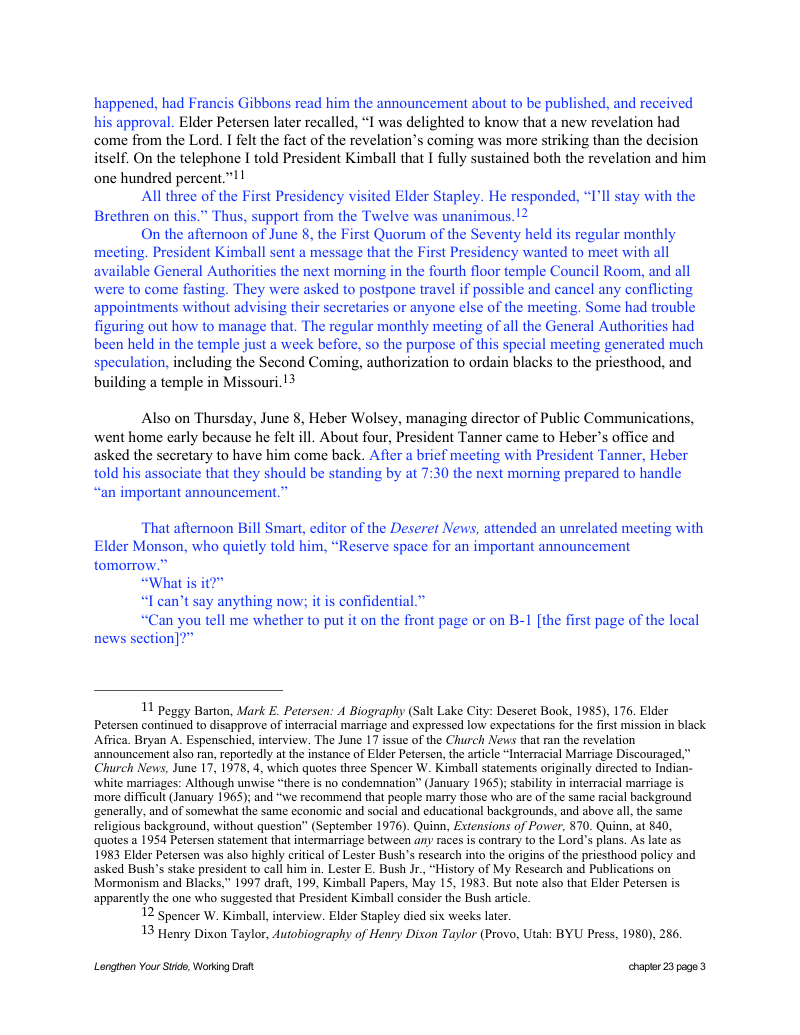According to Edward L. Kimball, Elder Delbert E. Stapley sustained the priesthood revelation.
- Type
- Book
- Hearsay
- DirectSecondary
- Reference
Edward L. Kimball, Working Draft, Digital Media, rep. Lengthen Your Stride: The Presidency of Spencer W. Kimball (Salt Lake City, UT: Deseret Book, 2005), ch. 23, 3
- Scribe/Publisher
- Deseret Book
- People
- Mark E. Petersen, Spencer W. Kimball, Peggy Barton, Thomas S. Monson, N. Eldon Tanner, Lester E. Bush, Marion G. Romney, D. Michael Quinn, Edward L. Kimball, Henry D. Taylor, Francis M. Gibbons, Heber Wolsey, William Henry Smart, Delbert L. Stapley
- Audience
- General Public
- Transcription
happened, had Francis Gibbons read him the announcement about to be published, and received his approval. Elder Petersen later recalled, “I was delighted to know that a new revelation had come from the Lord. I felt the fact of the revelation’s coming was more striking than the decision itself. On the telephone I told President Kimball that I fully sustained both the revelation and him one hundred percent.”11
All three of the First Presidency visited Elder Stapley. He responded, “I’ll stay with the Brethren on this.” Thus, support from the Twelve was unanimous.12
On the afternoon of June 8, the First Quorum of the Seventy held its regular monthly meeting. President Kimball sent a message that the First Presidency wanted to meet with all available General Authorities the next morning in the fourth floor temple Council Room, and all were to come fasting. They were asked to postpone travel if possible and cancel any conflicting appointments without advising their secretaries or anyone else of the meeting. Some had trouble figuring out how to manage that. The regular monthly meeting of all the General Authorities had been held in the temple just a week before, so the purpose of this special meeting generated much speculation, including the Second Coming, authorization to ordain blacks to the priesthood, and building a temple in Missouri.13
Also on Thursday, June 8, Heber Wolsey, managing director of Public Communications, went home early because he felt ill. About four, President Tanner came to Heber’s office and asked the secretary to have him come back. After a brief meeting with President Tanner, Heber told his associate that they should be standing by at 7:30 the next morning prepared to handle “an important announcement.”
That afternoon Bill Smart, editor of the Deseret News, attended an unrelated meeting with Elder Monson, who quietly told him, “Reserve space for an important announcement
tomorrow.”
“What is it?”
“I can’t say anything now; it is confidential.”
“Can you tell me whether to put it on the front page or on B-1 [the first page of the local news section]?”
-----
11 Peggy Barton, Mark E. Petersen: A Biography (Salt Lake City: Deseret Book, 1985), 176. Elder Petersen continued to disapprove of interracial marriage and expressed low expectations for the first mission in black Africa. Bryan A. Espenschied, interview. The June 17 issue of the Church News that ran the revelation announcement also ran, reportedly at the instance of Elder Petersen, the article “Interracial Marriage Discouraged,” Church News, June 17, 1978, 4, which quotes three Spencer W. Kimball statements originally directed to Indian-white marriages: Although unwise “there is no condemnation” (January 1965); stability in interracial marriage is more difficult (January 1965); and “we recommend that people marry those who are of the same racial background generally, and of somewhat the same economic and social and educational backgrounds, and above all, the same religious background, without question” (September 1976). Quinn, Extensions of Power, 870. Quinn, at 840, quotes a 1954 Petersen statement that intermarriage between any races is contrary to the Lord’s plans. As late as 1983 Elder Petersen was also highly critical of Lester Bush’s research into the origins of the priesthood policy and asked Bush’s stake president to call him in. Lester E. Bush Jr., “History of My Research and Publications on Mormonism and Blacks,” 1997 draft, 199, Kimball Papers, May 15, 1983. But note also that Elder Petersen is apparently the one who suggested that President Kimball consider the Bush article.
12 Spencer W. Kimball, interview. Elder Stapley died six weeks later.
13 Henry Dixon Taylor, Autobiography of Henry Dixon Taylor (Provo, Utah: BYU Press, 1980), 286.
The B. H. Roberts Foundation is not owned by, operated by, or affiliated with the Church of Jesus Christ of Latter-day Saints.

